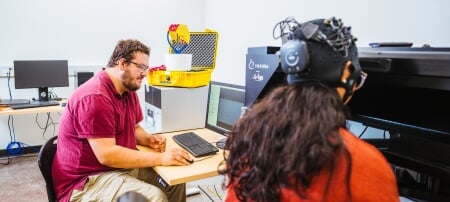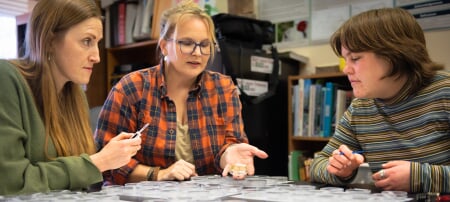A Little Light Magic

One of the mysteries of particle physics is supersymmetry, a brain-cramping theory that assumes every particle in the universe has a corresponding superpartner.
No one really knows if supersymmetry is real or not, yet the concept is so elegant that many eminent scientists believe it must be true and use it to solve complicated problems in quantum physics. Now a team of researchers, including a physicist at Michigan Technological University, has successfully applied supersymmetry concepts in the more down-to-earth field of optics. Their discovery could lead to solutions in applications as varied as lasers and high-speed data transmission.
“The equations for quantum mechanics are similar to those in optics, so we asked ourselves, ‘Can we take supersymmetry to an optical system?’ The answer is yes,” said Ramy El-Ganainy.
The team, including scientists at the University of Central Florida and Friedrich-Schiller-University in Germany, designed and built two arrays of waveguides connected by supersymmetry. Though much smaller, their waveguide arrays are similar to the fiber optic cables that use light waves to transmit data ranging from phone calls to email to TV signals.
One waveguide array was designed to transmit six different but related types of light waves called modes. The other waveguide array transmitted “superpartner” versions of five of those modes.
El-Ganainy explains. “Imagine you have a pendulum swinging back and forth. If you have an identical pendulum hanging next to it, they will collide and transfer each other’s energy.”
That was exactly what happened with the light waves in the team’s experiment. Of the six modes transmitted by the first waveguide array, five were phase matched. That allowed them to pass seamlessly from one waveguide array to the other. And that’s why this discovery could find its way into the bones of the Internet.
“Imagine it is 7 a.m., and every major city on the East Coast is experiencing the usual rush hour traffic,” said El-Ganainy. “Of equal importance, but less visibility, is the information traffic on the World Wide Web. It’s like a multi-level highway with traffic distributed on all levels, with the cars switching levels to get to their destination as fast as possible.” Supersymmetric waveguides offer a completely new technique for accomplishing those lane changes.
El-Ganainy doesn’t expect the team’s invention to transform the Internet anytime soon, however. Existing techniques already direct data very efficiently through the network, assuring, for example, that email sent by the US attorney general to the White House doesn’t accidentally end up in the inbox of the Washington Post. However, the team’s discovery could become the foundation of an entirely new class of optical devices. And their work has already shown that it’s possible to filter out all but one optical mode, which could have major implications for the development of powerful new lasers.
An article on the team’s work, “Supersymmetric Mode Converters,” was published April 16 in Nature Communications. The authors are Matthias Heinrich, Mohammad-Ali Miri and Demetrios N. Christodoulides of the College of Optics and Photonics at the University of Central Florida; Simon Stutzer, Stefan Nolte, and Alexander Szameit of the Institute of Applied Physics, Abbe School of Photonics, Friedrich-Schiller-University; and El-Ganainy.
Michigan Technological University is an R1 public research university founded in 1885 in Houghton, and is home to nearly 7,500 students from more than 60 countries around the world. Consistently ranked among the best universities in the country for return on investment, Michigan's flagship technological university offers more than 185 undergraduate and graduate degree programs in science and technology, engineering, computing, forestry, business, health professions, humanities, mathematics, social sciences, and the arts. The rural campus is situated just miles from Lake Superior in Michigan's Upper Peninsula, offering year-round opportunities for outdoor adventure.




Comments